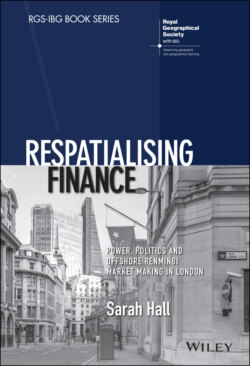Читать книгу Respatialising Finance - Sarah Hall - Страница 14
The Structure of the Book
ОглавлениеI develop this argument in seven further chapters that are divided into two parts. In Part I, Chapters 2 and 3 set out the theoretical basis and contribution of the book. In Chapter 2, I position RMB internationalisation within wider political economy approaches to international finance with a particular focus on the different ways in which the state plays an important role in shaping global finance. In Chapter 3, I explore how the financial district might be productively added to this literature in order to develop a meso-scale understanding of the financial centre as a territorial fix that is both shaped by and shapes global finance. In Part II of the book I operationalise and develop this conceptual approach through the case of RMB market making in London. In Chapter 4, I set out London’s role in RMB internationalization in more detail before describing my methodological strategies. Chapters 5, 6 and 7 each offer a different spatial cut through the ways in which London’s IFC serves as a territorial fix within RMB internationalisation.
In the second half of the book, I show how London’s financial district is not an inert backdrop upon which RMB internationalisation unfolds. Rather I focus on how IFCs, such as London, upload practices, conventions and relations into the global financial system of which they are a critical part. By focusing on the ways in which London has been enrolled into and shapes RMB internationalisation, I also aim at showing the fragilities, as well as the progress, of RMB internationalisation. These fragilities are particularly acute in relation to the challenges of aligning the interests of the Chinese state and the People’s Bank of China in particular who orchestrate the regulatory framework and parameters of RMB internationalisation with private sector financial market actors in the UK who are typically far less concerned with the success or failure of the wider process of RMB internationalisation. Indeed, my analysis in the second half of the book suggests that these relations will be central in determining the future shape of RMB internationalisation and London’s place within it.
In Chapter 5 I focus on how and why London was identified as being a financial centre that had the potential to serve as a territorial fix to meet political and economic aspirations in both London and Beijing. In Chapter 6, I turn to the work of Chinese financiers working in London and their employing financial institutions. Very little work thus far on RMB internationalisation has studied the process through the individuals working in financial markets and in related fields, notably in legal services. Here I focus on the extent to which the labour markets that have developed to serve RMB internationalisation based largely around elite Chinese migration to London are integrated, or not with existing international financial labour markets in London. Empirically, the analysis in this chapter points to the relatively limited ways in which Chinese finance has become embedded within London. This is in contrast to previous rounds of internationalisation in the City, notably through the rise of the US investment banking model in the 1980s that changed banking business models in the City far beyond the US firms through which it was imported (Kynaston 2002). Conceptually, this chapter demonstrates how respatialising our understandings of elite labour markets beyond financial centres in North America and Europe can enhance our understandings of financial work. In particular, I show how the state and state policy figures in what are often assumed to be highly liberal labour markets.
In Chapter 7, I shift scales again and focus on specific pieces of regulation that have been central to RMB internationalisation. In this chapter, I explore how such an approach allows the development of a more politically sensitive reading of how financial markets are made than has typified the cultural economy literature on finance to date (Hall 2011). I argue that the financial centre provides an important research site to develop this work because it reveals how the micro practices surrounding the implementation of specific regulations is co-constitutive of the financial and monetary networks of which they are a part. In so doing, I examine in more detail what it means to understand London as offshore within RMB internationalisation. As such, whilst each of these chapters focus on a particular aspect of RMB internationalisation and the relational optic that it produces, it is important to note that the multidimensional nature of RMB internationalisation means that each chapter inevitably also touches on the optics that are the focus of the other chapters.
In the final chapter I reflect on how a respatialised understanding of financial centres that takes seriously the ways in which they serve as territorial fixes that both respond to the changing nature of global finance but also shape it in particular ways through the production of relational optics might be used not only to understand both RMB internationalisation and London’s role within it but also develop more geographically and politically sensitive readings of global finance more broadly. This wider theoretical as well as empirical contribution is important because studying an empirical phenomenon such as RMB internationalisation is challenging given the pace of change.
